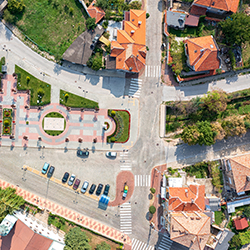Analyzing Traffic Patterns and Problem Areas
To effectively address traffic concerns, communities must first
conduct a thorough analysis of traffic patterns and identify problem areas. This involves collecting data on vehicle speeds, volumes, and types at different times and days.
Key steps in this process include:
- Mapping out high-traffic zones and accident-prone intersections.
- Observing peak traffic hours and determining the causes of congestion.
- Surveying pedestrian and cyclist activity to understand their impact on traffic flow.
Once the data is gathered, it can be used to pinpoint specific issues such as frequent speeding or bottlenecks. This information is crucial in selecting the right traffic calming device that will address the unique challenges of the community.
Engaging with Residents and Stakeholders
Effective engagement with residents and stakeholders is crucial when considering the implementation of traffic calming devices. Establishing partnerships and fostering collaboration among different parties, such as local authorities, can lead to more comprehensive and accepted solutions.
- Identify key stakeholders and resident groups within the community.
- Organize public meetings and workshops to gather input and discuss concerns.
- Utilize surveys and questionnaires to collect a wider range of opinions.
- Consider the formation of a steering committee to oversee the project.
Transparent communication and a participatory approach can significantly enhance the success of traffic calming initiatives. It is essential to ensure that the voices of all community members are heard and considered in the decision-making process.
Safety and Accessibility Considerations
When selecting traffic calming devices, safety is paramount.
Ensuring the safety of pedestrians and cyclists is as crucial as managing vehicle speeds. Devices must be designed to minimize risks for all road users, including the most vulnerable.
Accessibility is another key factor. Traffic calming measures should not create barriers for individuals with disabilities. Consider the following points:
- Adequate signage and markings for visibility
- Tactile paving for the visually impaired
- Sufficient space for wheelchair maneuverability
Incorporating these considerations into the design and selection of traffic calming devices will contribute to the creation of livable neighborhoods and enhance the overall quality of life.
Design and Placement of Traffic Calming Measures
Strategic Placement for Maximum Effectiveness
The strategic placement of traffic calming devices is crucial for their success in reducing speeds and enhancing safety.
Proper positioning can influence driver behavior and ensure that the devices are both noticeable and effective. For instance, placing speed humps directly after a curve can slow down vehicles that might otherwise accelerate.
Key considerations for placement include:
- Visibility to drivers
- Proximity to pedestrian crossings
- Distance from intersections and curves
Placement is equally critical in traffic calming measures such as the use of bollards. These should be strategically positioned to discourage speeding and reckless driving, serving as a physical and psychological barrier to encourage safer driving habits.
Design Considerations for Speed Bumps and Humps
When designing speed bumps and humps, it’s crucial to consider the specific environment where they will be placed.
The height and width of these devices must be tailored to target the desired speed reduction while minimizing discomfort for drivers and passengers.
- The material used for construction can vary from asphalt to rubber, each with its own longevity and impact on noise levels.
- The color and texture should be chosen to ensure high visibility, especially in areas with poor lighting or adverse weather conditions.
- It’s also important to integrate signage and road markings to alert drivers well in advance of the upcoming traffic calming feature.
Proper design will not only slow down vehicles effectively but also promote a smoother traffic flow and enhance the overall safety of the roadway.
Ensuring Proper Drainage and Roadway Maintenance
When integrating traffic calming devices, it’s crucial to consider their impact on
roadway drainage. Inadequate drainage can lead to water accumulation, which not only deteriorates the road surface but also undermines the effectiveness of the devices. To prevent such issues, engineers must design traffic calming measures that complement the existing drainage system or include modifications to it.
Proper roadway maintenance is equally important to ensure that traffic calming devices continue to function as intended. Regular inspections and repairs are necessary to address wear and tear, which can be exacerbated by heavy traffic and adverse weather conditions. Maintenance activities should include:
- Checking for and repairing any damage to the surface of speed bumps and humps.
- Ensuring that signage and markings are clearly visible.
- Clearing debris and sediment that may obstruct drainage channels.
By prioritizing drainage and maintenance, communities can maintain the integrity and effectiveness of their traffic calming strategies over time.
Implementation
Monitoring and Evaluating the Effectiveness
Once traffic calming devices are implemented,
monitoring and evaluating their effectiveness is crucial to ensure they meet the community’s goals. This involves collecting data on traffic speeds, volumes, and accident rates before and after installation.
- Regular assessments help identify any necessary adjustments or additional measures.
- Feedback from residents and local businesses provides valuable insights into the devices’ impact on daily life.
Collaboration with local law enforcement and traffic engineers can aid in interpreting the data accurately. By understanding the risks upfront, planners can develop targeted strategies to mitigate them effectively. This ongoing process ensures that the traffic calming measures continue to serve the community’s needs and enhance safety for all road users.
Conclusion
Ultimately, the decision to implement a suitable traffic calming measure is vital for improving both safety and the overall quality of life within a community. It is essential to comprehend the nuances between various devices, such as speed bumps and speed humps—their sizes, purposes, and effects on vehicle speed. When selecting an option, one must take into account the specific requirements of the community, the prevalent types of vehicles, and the target speed reduction. Consulting with local residents and specialists can offer crucial perspectives on the most effective strategies. The ideal selection will strike a balance between safety, functionality, and the preferences of the community, ensuring that the roads remain secure for everyone.

